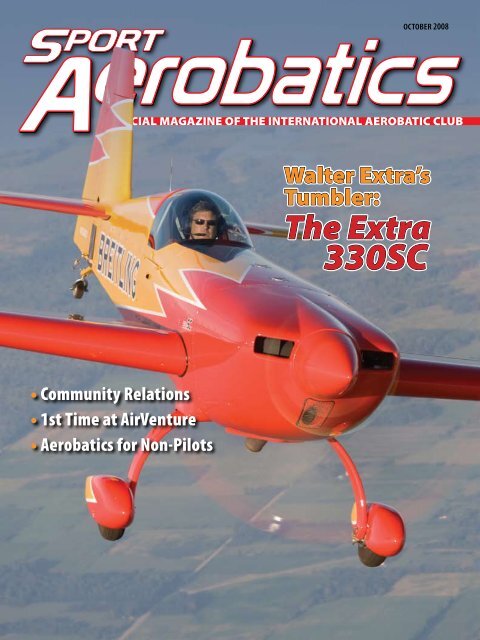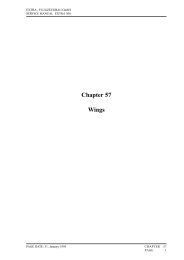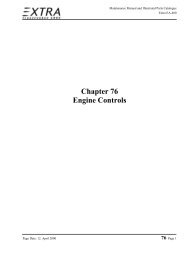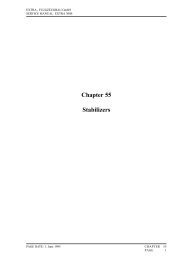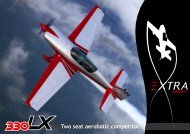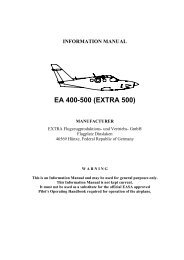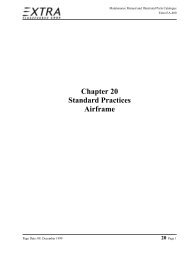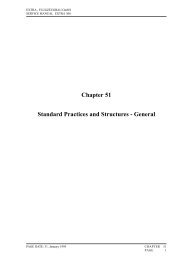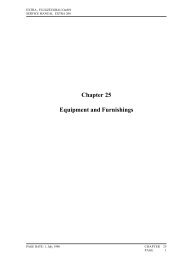2008-10 - Extra Aircraft
2008-10 - Extra Aircraft
2008-10 - Extra Aircraft
You also want an ePaper? Increase the reach of your titles
YUMPU automatically turns print PDFs into web optimized ePapers that Google loves.
OCTOBER <strong>2008</strong><br />
OFFICIAL MAGAZINE OF THE INTERNATIONAL AEROBATIC CLUB<br />
• Community Relations<br />
• 1st Time at AirVenture<br />
• Aerobatics for Non-Pilots<br />
Walter <strong>Extra</strong>’s<br />
Tumbler:<br />
The <strong>Extra</strong><br />
330SC
Bonnie Kratz<br />
The <strong>Extra</strong><br />
300SC<br />
Walter <strong>Extra</strong>’s New Unlimited Contender<br />
Budd Davisson<br />
At the pointy end of the aerobatic totem pole—the Unlimited category—winning is<br />
measured in micro-points, and this week’s killer competition airplane is next week’s<br />
also-ran. It’s an increasingly brutal arena in which the dance steps demanded by the<br />
choreographer would leave old Count Aresti breathless with astonishment. And it doesn’t appear<br />
likely that the trend toward extreme performance from both the airplane and the pilot will let up<br />
anytime soon.<br />
The recent drive to design aircraft that clearly outdistance the pack has forged a razor-edged<br />
competition between the various airplanes that are expected to successfully compete (read that<br />
as “win”) in Unlimited competition. At the same time, an unlikely market has developed just<br />
outside of competition in which pilots who have the wherewithal to own the most recognized,<br />
butt-kicking aerobatic bird will buy one just like their hero flies even though they have no<br />
intention of ever competing in it. It is this group that actually forms a market base wide enough<br />
to support the development of a new airplane, and it is a market Walter <strong>Extra</strong>, he of<br />
the airplanes of the same name, knows well. He has created a small empire<br />
by understanding that, if he builds a winning airplane flown by<br />
well-known champions, he will sell many more of the<br />
nearly identical airplane to serious pilots<br />
who just want to own the best<br />
aircraft available.<br />
6 • OCTOBER <strong>2008</strong> SPORT AEROBATICS • 7
The <strong>Extra</strong> 330SC is a definite departure from previous designs. The small canopy and redesigned tail are noticeable changes.<br />
The operative word in the foregoing equation is “winning<br />
airplane.” He knows well that the adoration<br />
and financial attention will quickly shift focus once<br />
one design has been eclipsed by another. It wasn’t until<br />
his airplanes began to lose favor, and Kramer Upchurch<br />
of Southeast Aero in St. Augustine, Florida, and champion<br />
competitor and air show performer Mike Goulian laid<br />
it on the line to him, that he took up the challenge to<br />
update his <strong>Extra</strong> 300 series.<br />
“Walter is an extremely creative guy,” Upchurch says.<br />
“But the company was focused on their corporate aircraft,<br />
the 400 and 500, and the 300S began to lose ground to<br />
the CAP 232 and the Edge 540. Serious competition pilots<br />
always buy the very best there is, and quite a number of<br />
top-level pilots left the <strong>Extra</strong> for a CAP or Edge.”<br />
Upchurch and Goulian visited <strong>Extra</strong> in 2005, and Walter,<br />
himself a winning competition pilot, responded by<br />
diving into his 300S, working down the items that were<br />
on the Upchurch/Goulian wish list.<br />
Pilots such as Mike Goulian had flown and competed<br />
in just about all of the existing Unlimited airplanes, and<br />
there was a wide consensus of opinion that the 300S was<br />
still a fine airplane. But if it was going to win Unlimited,<br />
some areas had to be addressed.<br />
“Everyone wanted more roll rate,” Upchurch says,<br />
“which, considering that it already rolled at 330-350<br />
degrees per second, shows just how demanding the competition<br />
market has become. However, it was more than<br />
just roll rate the pilots were looking for. They wanted the<br />
airplane to have more all-around maneuvering capabilities,<br />
particularly at lower airspeeds in the 60-knot range.”<br />
“Pilots also wanted more vertical performance,” says<br />
Upchurch, “which sounds a little crazy considering how<br />
far it would go vertical already, but there were airplanes<br />
with more vertical performance, so, if Walter wanted to<br />
keep selling airplanes, his had to go higher for longer and<br />
still be rolling well when coming to a stop at the top.”<br />
The competition guys were, in point of fact, becoming<br />
just a little spoiled and a tad blasé. With airplanes such<br />
as the Edge, Sukhoi, CAP, and <strong>Extra</strong>, the performance bar<br />
had been raised so high that incremental improvements<br />
were going to come slowly to an airplane such as an <strong>Extra</strong><br />
300S, but they expected it and they were willing to pay<br />
for it. And then the air show and freestyle parameters<br />
were stirred into the mix.<br />
Kramer points out another wish list item that’s new to<br />
this generation of aerobatic pilots.<br />
“The ability to tumble easily, predictably, and for longer<br />
periods of time has become an issue in recent years,”<br />
says Upchurch. “Where in the past any tumbling maneuver<br />
was just a novelty, they are now an aerobatic staple,<br />
and pilots—and audiences—expect them. Walter had to<br />
redesign his tail to make the airplane more aggressive in<br />
the way it tumbled.”<br />
The concept of intentionally tumbling an airplane isn’t<br />
something that’s taught in aerodynamic classes. Not even<br />
in graduate school. In fact, tumbling is the antithesis of<br />
what an aeronautical engineer strives for. He wants smooth<br />
flow, stable handling, and, until very recently, couldn’t<br />
computer-model (or even imagine) what the forces were—<br />
and where they went—in an airplane that was being made<br />
to act in a dynamic fashion that was anything other than<br />
aerodynamic: Tumbling often reverses the forces on the<br />
airframe but in ways that still aren’t totally understood.<br />
Plus, a traditional engineer is going to have next to no<br />
experience—practical or theoretical—in what you have to<br />
design into an airplane to make it better at tumbling.<br />
Much of what the engineering community knows<br />
about tumbling is empirical: Pilots figured out how to<br />
tumble the airplane in various ways and, when they broke<br />
something, the engineers had another data point to work<br />
with, which helped them in their design work. However,<br />
there aren’t many engineering types out there like Walter<br />
<strong>Extra</strong> who can tumble an airplane with the best of<br />
them. He came at the tumbling problem, as well as the<br />
other wish list improvements, from an entirely different<br />
perspective: He, more than most tech types, understood<br />
exactly what the market was saying it wanted and knew<br />
how to deliver it.<br />
Walter had lots of ideas about how to attack the wish<br />
list, but central to everything was improving the powerto-weight<br />
ratio. That meant more motor and less weight.<br />
He had already begun using the AEIO-580 with 330 hp<br />
on tap. However, to put the horsepower to work in the<br />
Bonnie Kratz<br />
330SC, as the new design was called, he used a new prop<br />
from MT that was specifically designed to give more lowspeed<br />
thrust. It had fatter, wider blades that were more<br />
efficient at putting the ponies on tap to work.<br />
“When it comes to weight,” says Upchirch, “Walter is<br />
fond of saying you lose it a gram at a time rather than<br />
pounds and kilos. But in this case, the grams removed<br />
total up to nearly 150 pounds lower than a 300S.”<br />
When shaving weight off of an aerobatic airplane, you<br />
don’t just start using smaller this and lighter that. It must<br />
be done while keeping the ultimate strength in mind at<br />
all times. Nothing can be compromised. In the case of<br />
the 330SC’s evolution from the 300S, the weight came off<br />
through the use of technology and careful planning. All<br />
push-pull tubes in the control system, for instance, are<br />
carbon fiber. The same carbon fiber concept is used on the<br />
wing ribs: Where once they were plywood, they are now<br />
carbon fiber. The firewall was lightened using titanium.<br />
The final airframe is rated at plus-and-minus <strong>10</strong> Gs, but<br />
loads to destruction show its limit actually exceeds 24Gs.<br />
Everywhere you look in the airframe there are new, stateof-the-art<br />
components.<br />
The roll rate issue was tackled in a very non-<strong>Extra</strong> sort<br />
of way. The ailerons are hinged so that, when deflected<br />
past a certain amount, the leading edges protrude a sizable<br />
distance above or below the wing. In so doing, to<br />
those of us in the cheap seats, it appears that rather than<br />
acting like regular ailerons that generate lift by changing<br />
the camber of the wing, these create a slot effect. At large<br />
deflections, this effect makes the aileron act as if it is a<br />
separate surface that generates lift on its own, independent<br />
of the wing. This is probably where the increased roll<br />
rate (430-450 degrees per second) gets its start.<br />
Although the new trapezoidal planform of the ailerons<br />
has to be pointed out to be noticeable, the unusual shape<br />
also helps in the roll rate department. Rather than being<br />
rectangular, as is traditional, the tips are quite a bit wider<br />
than the roots. It’s our guess that by moving the center<br />
of pressure of the aileron outboard, it gains leverage and<br />
can, with less effort, more quickly move the wing. It’s also<br />
worth noting that there isn’t even a hint of an aileron<br />
shovel to be seen, although Upchurch indicated that for<br />
European Aviation Safety Agency certifications, the shovels<br />
will go back on.<br />
An even more subtle change is seen in the taper of the<br />
wing. At the tip, the chord is much shorter, which, when<br />
combined with the new aileron, achieves the desired roll<br />
performance.<br />
The art of tumbling is one thing. The art of figuring<br />
out how to make an airplane flop end over end in a more<br />
predictable manner has to be something of a black art, part<br />
of which includes making the airplane snap outside better.<br />
This Walter knew how to do, but some of those changes,<br />
notably the new horizontal tail, helped in both areas.<br />
He went to slightly thinner airfoil sections with less radius<br />
on the nose. This made them more critical, so he could<br />
get them to stall more predictably. The span is shorter and<br />
the elevator balances are noticeably different.<br />
Continued on page 12<br />
8 • OCTOBER <strong>2008</strong> SPORT AEROBATICS • 9<br />
Photos by Budd Davisson and Craig VanderKolk<br />
From nose to tail, the new <strong>Extra</strong><br />
330SC incorporates changes<br />
that make it lighter and more<br />
maneuverable. Mechanically<br />
adjustable foot pedals and carbon<br />
fiber push rods save weight, while<br />
trapezoidal ailerons and new<br />
geometry on the tail improve rolling<br />
and tumbling maneuvers.
“<strong>Extra</strong> <strong>Extra</strong>! Read All About It!”<br />
OnE MAn’S OPInIOn OF THE ExTRA 330SC<br />
Carl Pascarell<br />
Doug Vayda, chief pilot for Southeast Aero, launched me in<br />
the SC with uncharacteristically subdued advice: “Don’t<br />
have too much fun and don’t hurt yourself too badly.”<br />
When you first approach the airplane, you get a sense of its<br />
performance while still 50 feet away. Simply put…big motor,<br />
little airframe. This is no doubt gonna be a monster. But no ogre<br />
this—oh no. The ’580 is so elegantly cowled, the rest of the airplane<br />
just seems to flow back from it. The fit and finish are firstclass,<br />
consistent with the established <strong>Extra</strong> tradition. This particular<br />
SC, with its Mirco Pecorari custom-designed paint scheme,<br />
dripped with performance potential and raw sex appeal.<br />
Entering the cockpit is typically <strong>Extra</strong>: foot step on fuselage,<br />
stand up on seat, and wiggle your feet forward under the instrument<br />
panel and onto the rudders. Rudders on the SC are not<br />
electrically adjustable as on the other <strong>Extra</strong>s. (Remember the<br />
weight thing?) Fortunately, the seat is three-way adjustable,<br />
allowing Patty Wagstaff-sized pilots as well as Doug Vayda-sized<br />
pilots an easy fit given two minutes and a couple of “pull pin”<br />
seat adjustments. To me (5 feet <strong>10</strong> inches, 180 pounds), the<br />
cockpit felt just about perfect: a definite “wearing the airplane”<br />
sort of impression without feeling cramped or jammed and just<br />
enough headroom to allow for the “negative G” stretch.<br />
Several “consumable” but less than ideal ergonomic features<br />
were noted, however. For instance, when at idle, the throttle is<br />
located too far aft to reach easily. A bit awkward initially, but<br />
once the throttle is advanced at all, this ceases to be a factor.<br />
Secondly, the aileron push-pull tubes pass directly under the<br />
pilot’s knees/calves and actually rub against those areas when<br />
the stick is pushed side to side. This is an issue for most averagesized<br />
individuals. Having said that, when in flight and particularly<br />
during maneuvering, it is scarcely noticeable and presents<br />
no impediment to control feel or response.<br />
Finally, there is an electric pitch trim toggle switch located on<br />
the upper instrument panel. It’s not convenient, and Doug assures<br />
me that on this and future examples the trim will be relocated to<br />
the stick, as with military fighters. Fortunately, because the airplane<br />
flies as if balanced close to the “neutral point,” very little trim is<br />
required throughout the normal range of speeds. Still, I would prefer<br />
good old-fashioned manual trim in an airplane like this.<br />
Engine start is straightforward and welcomes you with a<br />
jumping rumble under the hood reminiscent of a top fueler<br />
“nitro idling” on the starting line. The big ’580, with its six-intoone<br />
exhaust, sends pulses of power through the airframe and<br />
into your body, adding to the airplane’s already formidable<br />
presence. The taxi to the runway was expeditious in part due<br />
to the wide-blade MT dragging me along but also because of<br />
my eagerness to get airborne and explore this thoroughbred’s<br />
awesome capabilities. The wind was light and variable with the<br />
temperature at 79 degrees, and the airplane was loaded with<br />
full “aerobatic” fuel: 25 gallons and empty wings.<br />
Take-off acceleration was consistent with the current crop of<br />
high-powered competition machines, which is to say…exhilarating.<br />
I let the airplane fly off tail low and rotated to a truly<br />
ridiculous attitude in an attempt to hold what I figured was the<br />
best angle. Passing through 1,000 feet 14 seconds after liftoff—<br />
that’s right, 14 seconds—I turned west out of the pattern only<br />
to realize I was still only halfway down the runway! As you<br />
might imagine, 3,000 feet came pretty quickly, and the flight to<br />
the practice area was 190-knots quick.<br />
I have to admit, my initial impression was that the ailerons<br />
were heavier than I would have preferred. The very next flight<br />
I changed my mind. It was as if the ailerons got lighter. They<br />
didn’t, of course, and upon reflection I think my sense of what I<br />
expected the airplane to be may have colored my assessment.<br />
I decided further that the airplane is meant to be flown aggressively.<br />
When flown as such, the roll axis seems just about right.<br />
In fact, the more aggressively one flies the airplane the more<br />
harmonized the controls seem.<br />
Roll accelerations are extraordinarily high, generating rates in<br />
excess of 440 degrees per second with virtually no ramp-up. It’s<br />
like…Move aileron…Get roll….Right now! Here’s the kicker. A lot<br />
of airplanes roll like crazy. It’s not that tough a thing to get them<br />
to do, but not all of them can be well controlled. Frankly, this<br />
has been an issue for me with many of the <strong>Extra</strong>s I’ve flown. The<br />
ailerons are just too “bobbly” for my liking: no real center and, on<br />
some, an almost negative stick force gradient that makes precise<br />
roll control a chore until you get used to them. Well, fear not. The<br />
SC has set a new standard of roll control and authority for the<br />
<strong>Extra</strong>s. In fact, with the possible exception of the old ’230, it has<br />
the finest ailerons of any existing <strong>Extra</strong>. Crisp stops and lightningfast<br />
starts are well controlled with very little practice. Four-point<br />
rolls up, down, or anywhere in between are a head-banging,<br />
gear-shaking, bang, bang, bang, bang affair. Would I like them to<br />
be a bit lighter? Probably, but I’m likely just being picky.<br />
Overall, I felt the airplane’s basic handling qualities were<br />
pretty well managed. Stick forces in pitch were fairly light.<br />
Somewhat lighter pulling than pushing, but that suits me just<br />
fine. Things such as rolling turns suffer just a bit because of it,<br />
but only at first. The difference, as they say in test pilot parlance,<br />
is “consumable”—that is, adequately manageable.<br />
Snap rolls are quick and precise. Inside or out, up or down, single<br />
or multiple. This, I confess, I gleaned from watching the pros fly.<br />
Champions Patty Wagstaff and David Martin, each with virtually no<br />
time in the airplane, were snapping it as well as anything they’ve<br />
flown—as much a testament to their ability as the airplane’s.<br />
The subtleties of snap rolls and rollers are one thing, but to<br />
me, the truly impressive nature of the airplane is evident in the<br />
“wow” maneuvers. You know the “wow” maneuvers—<strong>10</strong>-roll<br />
torque rolls, double and triple nose-over-tail tumbles, knifeedge<br />
spins that you can barely hold onto, and tiny “micro loops”<br />
at 60 knots. These are the “YEE HA!” things that make the airplane<br />
so exhilarating and so memorable.<br />
Having quickly gained confidence in the SC, my second flight<br />
was in the low-altitude practice box at the St. Augustine Airport<br />
in Florida. My flight was a chaotic mass (or mess as some would<br />
have it) of one-after-the-other, body-punishing attempts to do<br />
all I could in 20 minutes.<br />
Vertical performance was exceptional, and I’m almost embarrassed<br />
to admit I actually pulled power from time to time to<br />
stay down in the box and keep from exceeding the 3,500-foot<br />
box ceiling and/or the 220 knot redline. now that’s precisely the<br />
type of problem I enjoy having in an airplane. I particularly liked<br />
the stability the airplane exhibited when stuck in the vertical. It<br />
was almost as if the airplane was flying with an “attitude hold”<br />
engaged. Once stuck there, very little attention was required to<br />
maintain the vertical. This was in part due to the low, off-speed<br />
trim requirement and was generally true for all lines and angles.<br />
I tended to concentrate on vertical and point maneuvers if<br />
for no other reason than they are so well done by the SC. Vertical<br />
four points up, inside, outside, inside triple vertical eights<br />
or “snowmen,” and the “how long is this gonna go on” torque<br />
rolls were pushing me over the “too much fun limit” Doug had<br />
warned me about.<br />
All high-alpha maneuvering was as well behaved and controllable<br />
as any aerobatic plane I’ve flown, the “micro loops”<br />
in particular. Starting at 60 knots and flown in full buffet with<br />
almost full aft stick, the roll and yaw axis throughout the loop<br />
were completely controllable with conventional control input,<br />
so much so that from the ground it was not apparent any buffet<br />
existed at all.<br />
All maneuvers were thrilling to say the least, but it was the<br />
knife-edge spins that captured my attention more than any<br />
other maneuver. Entry into the “knife” from a hammerhead was<br />
easily accomplished, even when the hammerhead pivot was<br />
sloppily flown. The pitch rate from the onset was eye-popping<br />
and almost beyond my ability to adequately hang onto. Three<br />
turns was the most I could hang onto, and even at that, I landed<br />
with the G-meter pegged on the negative end.<br />
My 20 minutes were up in short order and, taxiing back after<br />
landing, I recalled again what Doug had said about having too<br />
much fun. I knew what he meant. And I didn’t listen. With -+9Gs<br />
and -6 Gs on the meter, I dragged myself out of the airplane<br />
sweaty, bruised, and exhausted, huffing and puffing as if I’d just<br />
run 5 miles. I’m no stranger to high performance and generally<br />
not easily impressed, but man was that fun! It’s going to<br />
be interesting to see how the airplane’s future develops in the<br />
hands of true competition professionals.<br />
<strong>10</strong> • OCTOBER <strong>2008</strong> SPORT AEROBATICS • 11
Continued from page 9<br />
At the same time that <strong>Extra</strong> was looking for better performance,<br />
he also included some changes that gave the<br />
airplane greater utility. Specifically, the aerobatic header<br />
tank is now 26.7 gallons, which is almost twice what it<br />
used to be. Inasmuch as there can be no fuel in the wing<br />
tanks while doing hard aerobatics, that used to make the<br />
trip to the practice area and back a little dicey. The bigger<br />
aerobatic tank also adds a modicum of safety and peace<br />
of mind to aerobatic practice. There are 31 gallons in the<br />
wings, giving a total of 57 gallons usable, which gives a<br />
solid three hours of cruise at more than 190 mph with a<br />
wide reserve margin.<br />
AEROBATICS<br />
Basic through Unlimited<br />
Competition & Sport<br />
Safety & Proficiency<br />
Basic & Advanced Spins<br />
12 • OCTOBER <strong>2008</strong><br />
Pitts S-2B<br />
Super Decathlon<br />
Citabria<br />
MAINTENANCE<br />
FACILITIES<br />
We specialize in<br />
Fabric<br />
Tailwheel<br />
Aerobatic <strong>Aircraft</strong> Repair<br />
Owned and operated by Debbie Rihn-Harvey<br />
Is the 330SC the perfect airplane and is Walter happy<br />
with it? Probably not. No designer is ever totally happy<br />
with the final product, especially since an airplane is<br />
nothing but a bunch of compromises from the beginning.<br />
That’s the character of the beast. However, what is important<br />
is whether the competition community is happy with<br />
the changes that have been made and whether the airplane<br />
can regain its crown. The jury is still out on that score, and<br />
we’re at the end of the competition season. The debate will<br />
have to wait until spring to be settled. With all the new<br />
hardware showing up in the box, the coming competition<br />
season promises to be the most exciting ever.<br />
Featuring ratchet seatbelt system<br />
Hooker Custom Harness<br />
324 E. Stephenson St.<br />
Freeport, Illinois 6<strong>10</strong>32<br />
Phone: (815) 233-5478<br />
FAX: (815) 233-5479<br />
E-Mail: info@hookerharness.com<br />
www.hookerharness.com<br />
— Dealer for Strong Parachutes —<br />
Bonnie Kratz


